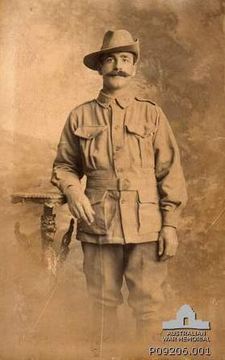
WATTS, George
| Service Number: | 208 |
|---|---|
| Enlisted: | Not yet discovered |
| Last Rank: | Lance Corporal |
| Last Unit: | 15th Infantry Battalion |
| Born: | Laugharne, Carmarthenshire, Wales, United Kingdom., 4 February 1883 |
| Home Town: | Townsville, Townsville, Queensland |
| Schooling: | Not yet discovered |
| Occupation: | Miner |
| Died: | Died of wounds, At sea aboard Hospital Ship Huntsgreen, Gallipoli, Dardanelles, Turkey, 30 August 1915, aged 32 years |
| Cemetery: |
No known grave - "Known Unto God" Lone Pine Memorial, Gallipoli Peninsula, Canakkale Province, Turkey |
| Memorials: | Australian War Memorial Roll of Honour, Lone Pine Memorial to the Missing |
World War 1 Service
| 22 Dec 1914: | Involvement Private, 208, 17th Infantry Battalion, ANZAC / Gallipoli, --- :embarkation_roll: roll_number: '11' embarkation_place: Melbourne embarkation_ship: HMAT Ceramic embarkation_ship_number: A40 public_note: '' | |
|---|---|---|
| 22 Dec 1914: | Embarked Private, 208, 17th Infantry Battalion, HMAT Ceramic, Melbourne | |
| 30 Aug 1915: | Involvement Lance Corporal, 208, 15th Infantry Battalion, ANZAC / Gallipoli, --- :awm_ww1_roll_of_honour_import: awm_service_number: 208 awm_unit: 15th Australian Infantry Battalion awm_rank: Lance Corporal awm_died_date: 1915-08-30 |
Help us honour George Watts's service by contributing information, stories, and images so that they can be preserved for future generations.
Add my storyBiography contributed by Geoffrey Gillon
Births Jun 1883 WATTS George Carmarthen 11a 892.
George was born in Laugharne on 4 February 1883, the son of John and Esther Watts, who lived at The Lakes, Laugharne. He had two elder brothers Thomas and William Watts, who later lived at 25, Biggyn Road, Llanelli. George had a taste for adventure. On 31 May 1902, he enlisted at Devonport in the Royal Navy, signing up for 12 years. He served for over five years in the Royal Navy on active service, and for six years on the reserve. In 1914, George was in Australia, working as a miner, and on 28 September 1914, he enlisted in Townsville, into the 15th Battalion, Australian Imperial Force, which was part of 4 Brigade, 4th Australian Division. He embarked from Melbourne on 22 December 1914 aboard the Australian Troopship Ceramic, bound for Egypt. On 25 April 1915 the Australians landed on the shores of Anzac Cove, Gallipoli, and were thrown into desperate fighting. From May to August, the 15th battalion was heavily involved in establishing and defending the ANZAC front line. On 14 July 1915 he was admitted to the 4th Field Ambulance, and sent to the Greek Island of Mudros, with a boil on his neck. He returned to Gallipoli, but was again admitted to the 4th Field Ambulance at Anzac beach on Gallipoli on 11 August 1915. He returned to his Battalion the next day and was caught up in one of the final stages of the Gallipoli campaign, the Battle for Hill 60. A detachment from 'A' Company of the 15th Battalion was sent to reinforce the 13th Battalion’s unsuccessful attempt to take the position. It was during this futile struggle that George was wounded, and taken to the 16th Casualty Clearing Station, on 27 August 1915, to be treated for a gunshot wound to his left arm. George was ferried aboard the hospital ship Huntsgreen, where he died of his wounds on 30 August 1915. The chief officer aboard the Huntsgreen buried George at sea that day.
He is commemorated in his native township on the Laugharne War Memorial; Laugharne Laugharne sits in a peaceful location in a valley at the outlet of the Rivers Tâf and Corran. The men of Laugharne who fell in both World Wars are commemorated on two separate Memorials in St. Martins Church and also on a relatively new memorial sited outside the newly rebuilt Memorial Hall, in Clifton Street, which bears the same names. Also commemorated on the war memorial is Lance Corporal David Thomas John [shown as Johns] of the 4th Bn. Australian Infantry, A.I.F. who fell in France on 18th August 1916, aged 25.












